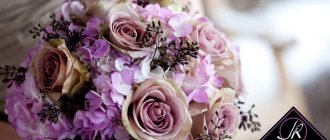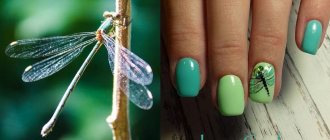Lavender is an attractive and fragrant plant that is widely used in landscape design. The most commonly grown plant is angustifolia lavender. This versatile flower looks organically in a variety of compositions. Here are some examples.
In the northern regions, lavender is grown as an annual, since this lover of warmth and sun does not always survive the harsh winter safely. And in mild climates, angustifolia lavender is a perennial shrub that, with proper care and proper pruning, decorates the garden every summer with its delicate lilac-violet inflorescences.
- Lavender in open ground - planting, care, propagation
Everything you wanted to know about growing lavender.
- How to grow lavender from cuttings and seeds at home
Step-by-step instructions with photos for propagating lavender. Everything is much simpler than you think!
The versatility of lavender allows it to be used in any composition. But landscape designers prefer these methods of landscaping a site.
Flowerbed with herbs and lavender
Do you want to have a fragrant flowerbed on your property? Plant rosemary, dill, sage, thyme, mint, oregano, yarrow, etc. next to the lavender. The pleasant and healing smell that will emanate from such an unusual flower garden will make this corner your favorite vacation spot.
- Herb garden - a fragrant bed on the site
7 fragrant plants for your garden.
- 8 Great Herbs for a Purple Garden
The best garden plants to decorate your garden and add to tea.
Ideas
Both fresh flowers and dried twigs are used to create bouquets. As the experience of florists shows, the last option, although very original, is not very practical, because dry twigs break easily . Boutonnieres made from them for the groom threaten to crumble after the first congratulatory hug from relatives and friends. In addition, dried plants do not have the charming aroma that is inherent in freshly cut ones.
Florists create flower arrangements in which lavender is the soloist or reigns supreme, and complements larger inflorescences. But in any case, lavender is able to decorate any bouquet.
Mono bouquet of lavender
The noble lilac color of lavender is combined with traditional pastel wedding colors , and after a few hours the cut branches of lavender acquire a darker, noble shade.
Important! The use of lavender alone presupposes a free-form bouquet, since the structure of the flower almost does not allow creating the hemispherical or spherical shape that is classic for wedding celebrations.
The mono-bouquet fits perfectly into images in the boho or Provence style , and its composition is more than simple. It is enough to cut a few sprigs of lavender, assemble them into a composition and decorate them as you wish:
- Tie the stems with a thin ribbon to match the bouquet. Most often, florists prefer lilac, violet, lilac or pastel satin ribbons;
- Wrap the stem-leg with a thin ribbon and hide the end;
- Wrap the stems with a small piece of burlap and tie with thick woolen thread or twine to match the bouquet. Another option is to pin the burlap with a vintage brooch ;
- Do not use decor. This bouquet is suitable only for a very simple bride’s look. In addition, it is not very convenient, because without fastenings it can fall apart.
Peonies
Peonies are flowers with huge and lush buds that can play the role of a bright accent in a bouquet and in the image of the bride as a whole. The combination of white peonies and lavender is one of the classic options for wedding compositions. White and purple colors go well together. Large buds of peonies with long branches of lavender also harmoniously coexist.
This bouquet is usually made in the shape of a small hemisphere so that the bride can hold it comfortably. The flower stems are tied with a delicate ribbon of white or purple, lilac or soft lilac color.
The color of the ribbon should match the bouquet and the image of the bride as a whole. It is better to give preference to pastel shades and tie the bouquet with a soft purple or light lilac ribbon than to choose a bright accessory that will distract attention from the composition and will look ridiculous and pretentious.
Orchids and white roses
Orchids and white roses are traditional flowers for modern wedding celebrations. In combination with lavender, they remain the same classic basis for a bouquet , but they look more impressive, because the branches of fragrant lavender skillfully place accents.
Florists have a lot of scope for imagination, since many varieties of wedding bouquets can be made from roses, orchids and lavender, as well as with the help of floral decor.
One of the incredible examples of creativity will be a bouquet of long green ears, just below the heads of which there are sprigs of lavender, and even lower - a ring of small white roses. The base of the composition was decorated with a skirt made of white satin ribbon. This accessory will suit a bride in a shabby chic style.
Often, about a third of all stems are wrapped with tape, and its tip is hidden. In this case, it is important to ensure that the ends of the ribbon are securely fixed so that the bouquet does not fall apart.
Wildflowers
If the French Provence style is close to you, then you will certainly like a bouquet of wildflowers , especially if the wedding event is designed in this style.
Provence is characterized by the tenderness and simplicity inherent in the French suburbs, so the goal of a composition of wildflowers is to create the feeling that the bouquet has been hastily assembled in one of the fields of Provence during a walk.
Important! Floral “skirts”, clear shapes, and especially foam frames will definitely not suit a lavender bouquet of wildflowers.
The composition is composed deliberately chaotically, without giving any specific shape , and either ribbon or decorative rope is used as decoration.
Goes great with lavender:
- sunflowers;
- mallow;
- chamomile;
- clover;
- irises;
- bells;
- wild lilies;
- buttercups;
- poppies
Bells, buttercups, daisies, clovers are very delicate flowers with small buds, and in combination with lavender they will create a modest, but sweet and delicate bouquet. In the case of lush and bright flowers - sunflowers, irises, field lilies - you need to think through the composition to the smallest detail so that it does not turn out to be too pretentious.
Often a bouquet of wildflowers is decorated with ears of wheat and fern branches. This technique is best used for voluminous bouquets, although a few spikelets will not be superfluous in a small, modest accessory.
Proper care of lavender
For the most part, various types of lavender are not demanding of special conditions - they are completely independent and can grow without human intervention. However, in order for the plant to delight you with the most lush, long-lasting flowering and incomparable aroma, you still have to take care of it.
Lighting
Lavender is a light-loving plant. The most favorable length of daylight for her is 8–10 hours. It is better to display indoor specimens on the balcony from spring to early autumn. When planting a crop on a personal plot, it is necessary to choose open, unshaded areas.
Live or artificial lavender: which is preferable?
There is no doubt that only living lavender bushes can fill the room with their unique Provençal scent. But the deliberate capriciousness of the plant outweighs this “fragrant plus”. Therefore, it is worth considering beautiful artificial flowers for the interior as a reasonable alternative, which can be purchased at an attractive price in the Treez Collection catalog.
The difficulty of growing lavender in pots at home:
- The living plant is very light-loving. He needs access to sunlight at least 8 hours a day. Therefore, you will have to allocate the most illuminated window sill in your house for lavender bushes. The artificial analogue does not need access to the sun - compositions can be placed even in a darkened corner of the room.
- Space is important. The lavender root is long in structure, so if it grows against the bottom of the pot, the spikelets will stop growing. Living vegetation will have to choose a deep and wide pot. The bulkiness of such a floral composition is not acceptable for any interior. But an artificial specimen can be easily placed in a compact flower pot.
- Lavender needs warm, fresh air. You will have to take it out to the balcony or veranda, but the temperature there should not fall below 15° C. The thermal regime in the room must also be observed, which will not need to be monitored if you purchase inanimate flora.
- Stagnation of water and excessive “drinking” will lead to the death of this capricious plant. It is necessary to water as the soil dries, which, by the way, should be nutritious, with a good layer of drainage. Regular feeding is also needed, which will not be necessary when placing artificial potted lavender.
As for cutting, lavender bunches will last only 2-3 days in water. Artificial compositions in vases will delight the eye for an unlimited time.
Lavender in garden design – stylish ideas
The versatility of lavender opens up great possibilities for landscaping. Knowing where and with what flowers it is better to plant lavender, you can decorate the area in accordance with the latest floristry trends.
Lilac haze over an alpine hill
Under natural conditions, lavender most often grows on rocky mountain slopes. If you try to recreate similar conditions, she will be grateful to you. Plant a perennial surrounded by irregular stones - the combination of delicate inflorescences with cold hard rock looks natural and very attractive. In this case, spicy plants will be good neighbors - mint, basil, sage, lemon balm.
The central component of the mixborder
Where to plant lavender to make it the centerpiece of a multi-row arrangement? In the mixborder! The shrub can be combined with any low and medium-sized plants. Cosmea, stachys, alyssum, astrantia, clematis, poppy, and sedum can highlight the beauty of lilac spikelets. White, pink, red, yellow colors will be an excellent complement to the openwork lilac flowers of lavender.
Fluffy lavender border
Lavender bushes planted along straight and winding garden paths look fabulous. Don't pass up the opportunity to turn your property into a magical kingdom. Plant lavender along your paths to make walks in your garden even more enjoyable.
Living borders can be used for zoning. The aroma of this plant calms and relieves stress after a hard day at work, which means that a lavender fence can be used to designate an area of rest and relaxation.
Lavender + roses = great duet
Lavender in landscape design is combined with many perennials, but fashion trends strongly recommend introducing a native of the mountainous regions of the Mediterranean to sophisticated roses. Lavender against the background of large bright rose buds becomes even more noticeable, and the mixture of enchanting aromas sets the mood for a romantic mood.
Brilliant Solitaire
Friendly lavender can be planted in splendid isolation. In solitaire plantings, it does not lose its original charm and even doubles it. A lawn decorated with lavender islands will attract everyone's attention. If you have free space, plant everything with fragrant perennials - you will get a lavender field that will inspire admiration.
Best balcony decoration
Where to plant lavender if you do not own large-scale land? She will do almost as well in a spacious container as in the garden. Lavender Lady, Manstead Strain, Aroma of Provence and other dwarf varieties are ideal for growing in pots. If you want to turn the bushes into a memorable art object, then plant them in an original jug, painted flowerpot or tin watering can.
Bright hedge
Growing lavender in the garden has both decorative and practical benefits. Tall varieties Victory, Yuzhanka, Tenderness are perfect for creating a hedge. A dense plant curtain creates a barrier both for curious neighborhood boys and for insects that do not tolerate the lavender aroma well. By the way, for the same reason, lavender is often planted in garden beds.
Healing flower bed
Those who value the beneficial properties of lavender should set up a natural green “first aid kit”. Place lavender, sage, yarrow, rosemary, thyme, mint in your flowerbed and you won’t have to look for cures for insomnia, headaches, anemia, hypotension and other common diseases. In addition, the listed plants can be used in the preparation of salads and hot dishes.
Do you want to learn about the rules for planting lavender in open ground? Watch the video on how to create favorable conditions for the development of an overseas beauty.
Write in the comments whether you like lavender and what place in the garden you chose to plant this beautiful plant.











